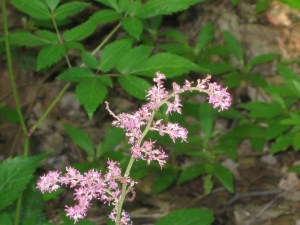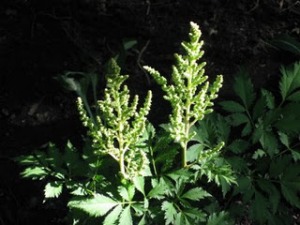Last updated on December 2nd, 2011

I want to say a kind word for the astilbe, a too-little planted perennial with ferny foliage and deliciously fragrant plumes of white, pink, or red. Its delicate appearance defies a cast-iron constitution. In the face of a gale-force wind or a hard, driving rain, the plant merely yawns. Deer, rabbits, and woodchucks leave it alone. Indeed, the astilbe is a perfect plant.
 Culture: These tourists from the far-East are among the easiest plants to grow. Prepare the soil deeply, and amend it with copious quantities of leaf mold. A three inch layer of mulch is essential for moisture-retention (astilbes loathe dryness). The plants will bloom a little in deep shade, but for bigger and better flowers, permit them a little sun. Most varieties are hardy in zones 4-8.
Culture: These tourists from the far-East are among the easiest plants to grow. Prepare the soil deeply, and amend it with copious quantities of leaf mold. A three inch layer of mulch is essential for moisture-retention (astilbes loathe dryness). The plants will bloom a little in deep shade, but for bigger and better flowers, permit them a little sun. Most varieties are hardy in zones 4-8.
 I am keen on astilbes of all kinds. Bordering a path in the open shade of my Woodland Garden is a colony of ‘Bressingham Beauty,’ which opens its rosey-pink spires from late-June through mid-July. Across the path is a group of creamy-white, maturing-to-pink ‘Milk and Honey’ that blooms from late-July through August. Both varieties grow to a height of 3 1/2 feet.
I am keen on astilbes of all kinds. Bordering a path in the open shade of my Woodland Garden is a colony of ‘Bressingham Beauty,’ which opens its rosey-pink spires from late-June through mid-July. Across the path is a group of creamy-white, maturing-to-pink ‘Milk and Honey’ that blooms from late-July through August. Both varieties grow to a height of 3 1/2 feet.
Why fuss and fret over your rain-ravaged roses or diseased delphiniums? Plant lots of astilbes, and enjoy several seasons of easy beauty. Besides ‘Bressingham Beauty’ and ‘Milk and Honey,’ you can easily find deep pink ‘Rheinland,’ red ‘Fanal,’ white ‘Snowdrift’ and purplish-red ‘Purple Candles.’
If you would like to be notified of new posts at A Garden for the House (and why wouldn’t you?), simply enter your email address here.
Related Posts (click title to read):
The Woodland Garden
Four Fabulous Ferns
Tip: How To Find Free Mulch

Andrew Thompson says
When do you divide astilbes? I have a red variety that is getting very large. Thanks!
Eric says
I'll take any plant that yawns in the face of a hard, driving rain!!!
Kevin Lee Jacobs says
Andrew – You can divide astilbe immediately after they have finished flowering. If the divisions wilt after planting, spray them gently with water twice each day for a week or so. They will quickly recover.
Donna says
Kevin, you said that deer and rabbits do not bother astilbes, but what about slugs and snails? I have a major issue with these slimy creatures!
Kevin Lee Jacobs says
Donna – Astilbes are slug- and snail-proof, too.
Kim says
Will Astilbe work well in the Atlanta, Georgia area? I think we had them years ago but when I asked my husband (the yardener) he said they won’t do well because it’s too hot here.
Mary says
Have Hostas all over my property. I have made tons of new plants from these different kinds of variety!